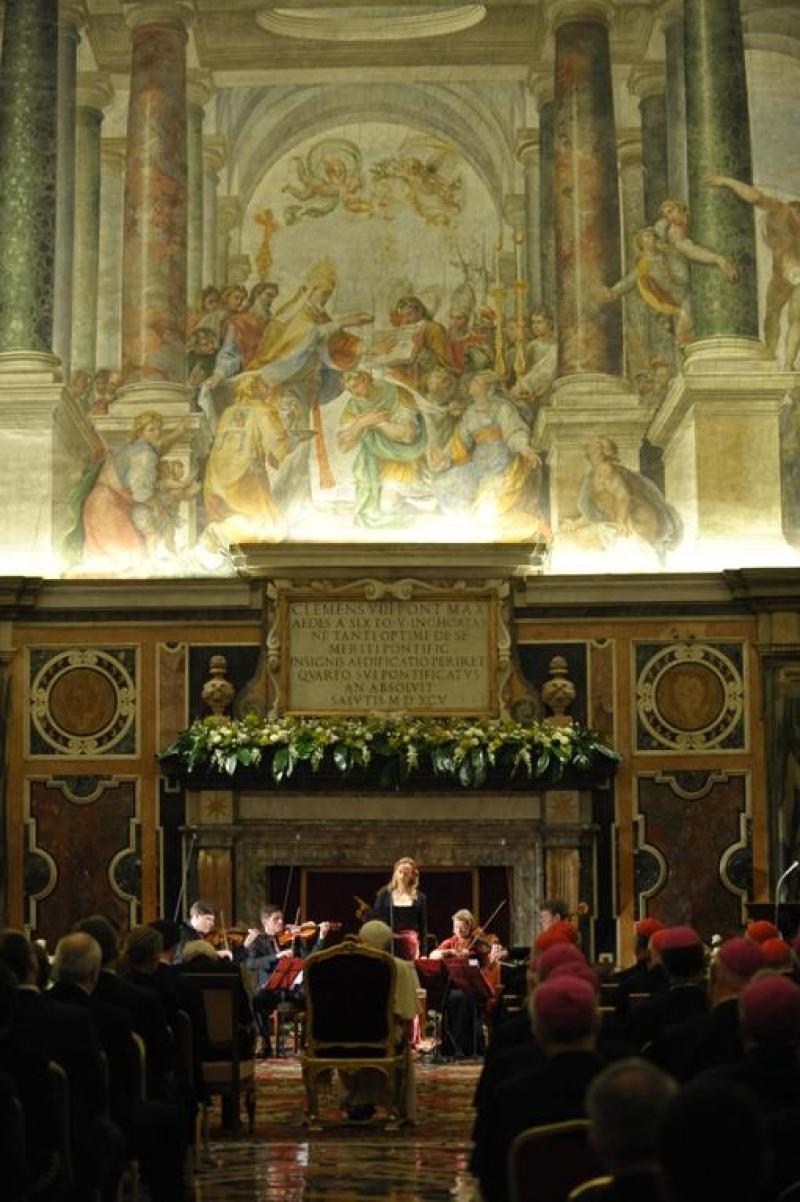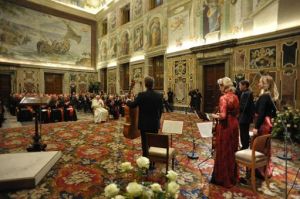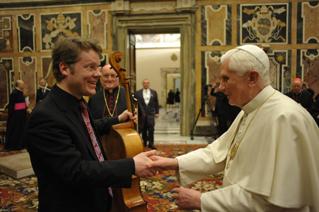theartsdesk in the Vatican: In an Audience with the Pope | reviews, news & interviews
theartsdesk in the Vatican: In an Audience with the Pope
theartsdesk in the Vatican: In an Audience with the Pope
Haydn privately performed for Benedict XVI

At the Vatican, recently, the Pope attended a concert in his honour in the Sala Clementina. This is the great double-height room which stands at the entrance to the private papal apartments; it is where Pope John Paul II’s body lay in state almost exactly five years ago. I was one of about 150 guests, at least a third of whom were cardinals, bishops and other senior clerical figures. As we arrived there was the most ornate and intricate gavotte of seat-taking, lasting a good 40 minutes.
While this eddied around us, one of the English critics and I (fortified by a clerical collar, not that that normally gets you very far in Rome) drifted towards the front and found ourselves, unchallenged, in the third row. Very satisfactory, though not recommended by scripture (we fully expected to be moved to the back).
The concert was for the Pope’s name day, of course, his festa onomastica. And Joseph was indeed the name of the day, as the piece chosen was Joseph Haydn’s Seven Last Words. This sublime sequence of slow movements was originally commissioned (in 1787) for liturgical use in Cádiz, and has gone through various transcriptions. Haydn himself made three: orchestral and choral, as well as the most familiar, the string quartet version.
This was yet another, made by the composer to the Royal Spanish Court, Jose Peris Lacasa. He has added a mezzo-soprano to the quartet, who sings phrases from the Last Words to melodic lines lifted from (or sung with) the first violin part. The musical content, as far as I could tell, was absolutely as in the original, but with the singer interweaving here and there. The singer was Susanne Kelling, the players the Henschel Quartet. These are artists of the highest international calibre, as you would expect for such an occasion. They were also playing on Stradivarius instruments lent by the Spanish court.
 The performance was quite sensational. The acoustic of the Sala Clementina suits chamber music: it is generous, almost bathroomy, but the room is small enough not to lose any clarity or detail. The quartet played with that kind of organic togetherness you hear in the best quartets, who breathe together. That three of the four are Henschel siblings only adds to the intensity of their communication – between themselves and to the listeners. They ranged from powerful, emphatic strength to the lightest, filigree delicacy. It was entirely at the service of the music, and, I suspect, at the service of the very Last Words themselves. This performance did have a quasi-liturgical character to it.
The performance was quite sensational. The acoustic of the Sala Clementina suits chamber music: it is generous, almost bathroomy, but the room is small enough not to lose any clarity or detail. The quartet played with that kind of organic togetherness you hear in the best quartets, who breathe together. That three of the four are Henschel siblings only adds to the intensity of their communication – between themselves and to the listeners. They ranged from powerful, emphatic strength to the lightest, filigree delicacy. It was entirely at the service of the music, and, I suspect, at the service of the very Last Words themselves. This performance did have a quasi-liturgical character to it.
It is well attested that the Holy Father loves such music. His brother Georg, the priest-musician, was there to hear it too. And so, unlike so many glittering private concerts of this kind, there was aesthetic seriousness at its heart. We were all caught up in the performance, but we were also present at a very particular encounter. Here was the Successor to Peter (placed centrally and forward of everyone else, so in a sense alone) listening to the Last Words of Christ, the Christ who forgave Peter his denials and entrusted the future of his church, his sheep, to his care and love - all this mediated through music. And that care is not just some airily sweet notion, not some pious platitude, given the very pressing cares of the present situation.
If I have a quibble, it is to wonder whether this version of the Haydn was actually worth making. The original conception - a sequence of biblical quotations (the Last Words themselves), homilies and musical movements – allows for a richness of experience, thought and inspiration which does justice to the importance of the original narrative. Putting it at its crudest, there are times for words to stop. Even if you can, as it were, hear the Latin texts, or bits of them, in the musical themes, that is more of a resonance than a re-statement. The singing was committed and beautiful; but if the mezzo had sung the word "mulier" once more (in the woman, behold your son movement) I might have had an internal rupture. It would have been much more apposite to have heard the Last Words read, then allow each quartet movement to be a space for reflection.
 Pope Benedict gave a short address at the end, in Italian and German. He thanked the performers quite passionately. But the meat of his remarks was inspired by the music itself. The piece is “one of the most sublime examples of how to marry art and faith in music,” he said. “Hidden here is a universal law of artistic expression – the ability to communicate beauty, which is also good and true, through a medium of sense.” This applies to the other art forms, he added, and is “the same law that God followed to tell us of himself and his love: he was born in our flesh and has created the greatest masterpiece of all creation, the one mediator between God and men, Jesus Christ.”
Pope Benedict gave a short address at the end, in Italian and German. He thanked the performers quite passionately. But the meat of his remarks was inspired by the music itself. The piece is “one of the most sublime examples of how to marry art and faith in music,” he said. “Hidden here is a universal law of artistic expression – the ability to communicate beauty, which is also good and true, through a medium of sense.” This applies to the other art forms, he added, and is “the same law that God followed to tell us of himself and his love: he was born in our flesh and has created the greatest masterpiece of all creation, the one mediator between God and men, Jesus Christ.”
That this was a fascinating experience for me hardly needs saying: a Church of England priest invited to be part of something at the heart of the Vatican, something so small and private and rare. Quite apart from all the ecclesiastical features of interest (like seeing so many of the great hierarchs all in one place), it was irresistible to compare it with, say, such an event in Buckingham Palace. I haven’t been further than the forecourt there, as it happens, but even then we were passport-checked, cameras and mobiles emphatically forbidden and there were security personnel watching us from the roof.
Here there was much clicking and flashing of photography, with people (all women, bizarrely) walking determinedly to the front and snapping the Holy Father as he got up to receive the quartet and singer at the end. Security and protocol were done with a very light touch. The room was humming with a kind of tangible awe: febrile with anticipation for the Pope’s arrival; and tuned to his every reaction or move - whenever he stood, so did we, and clapping the while. He seemed relaxed, smiling warmly both to individuals and across the room; and strong – as he spoke, he occasionally raised his right hand in emphasis. It was a move a choreographer would recognise as real, not vague, signifying intention.
All in all, three Josephs were well served by this occasion.
- Fr Andrew Hammond is the Succentor of St Paul’s Cathedral. Before ordination he worked in the world of classical music.
- Find the Henschel Quartet on Amazon
- Find The Seven Last Words of Christ on the Cross on Amazon
Share this article
The future of Arts Journalism
You can stop theartsdesk.com closing!
We urgently need financing to survive. Our fundraising drive has thus far raised £49,000 but we need to reach £100,000 or we will be forced to close. Please contribute here: https://gofund.me/c3f6033d
And if you can forward this information to anyone who might assist, we’d be grateful.

Subscribe to theartsdesk.com
Thank you for continuing to read our work on theartsdesk.com. For unlimited access to every article in its entirety, including our archive of more than 15,000 pieces, we're asking for £5 per month or £40 per year. We feel it's a very good deal, and hope you do too.
To take a subscription now simply click here.
And if you're looking for that extra gift for a friend or family member, why not treat them to a theartsdesk.com gift subscription?
more Classical music
 Robin Holloway: Music's Odyssey review - lessons in composition
Broad and idiosyncratic survey of classical music is insightful but slightly indigestible
Robin Holloway: Music's Odyssey review - lessons in composition
Broad and idiosyncratic survey of classical music is insightful but slightly indigestible
 Bizet in 150th anniversary year: rich and rare French offerings from Palazzetto Bru Zane
Specialists in French romantic music unveil a treasure trove both live and on disc
Bizet in 150th anniversary year: rich and rare French offerings from Palazzetto Bru Zane
Specialists in French romantic music unveil a treasure trove both live and on disc
 Scottish Chamber Orchestra, Ibragimova, Queen’s Hall, Edinburgh review - rarities, novelties and drumrolls
A pity the SCO didn't pick a better showcase for a shining guest artist
Scottish Chamber Orchestra, Ibragimova, Queen’s Hall, Edinburgh review - rarities, novelties and drumrolls
A pity the SCO didn't pick a better showcase for a shining guest artist
 Kilsby, Parkes, Sinfonia of London, Wilson, Barbican review - string things zing and sing in expert hands
British masterpieces for strings plus other-worldly tenor and horn - and a muscular rarity
Kilsby, Parkes, Sinfonia of London, Wilson, Barbican review - string things zing and sing in expert hands
British masterpieces for strings plus other-worldly tenor and horn - and a muscular rarity
 From Historical to Hip-Hop, Classically Black Music Festival, Kings Place review - a cluster of impressive stars for the future
From quasi-Mozartian elegance to the gritty humour of a kitchen inspection
From Historical to Hip-Hop, Classically Black Music Festival, Kings Place review - a cluster of impressive stars for the future
From quasi-Mozartian elegance to the gritty humour of a kitchen inspection
 Shibe, LSO, Adès, Barbican review - gaudy and glorious new music alongside serene Sibelius
Adès’s passion makes persuasive case for the music he loves, both new and old
Shibe, LSO, Adès, Barbican review - gaudy and glorious new music alongside serene Sibelius
Adès’s passion makes persuasive case for the music he loves, both new and old
 Anja Mittermüller, Richard Fu, Wigmore Hall review - a glorious hall debut
The Austrian mezzo shines - at the age of 22
Anja Mittermüller, Richard Fu, Wigmore Hall review - a glorious hall debut
The Austrian mezzo shines - at the age of 22
 First Person: clarinettist Oliver Pashley on the new horizons of The Hermes Experiment's latest album
Compositions by members of this unusual quartet feature for the first time
First Person: clarinettist Oliver Pashley on the new horizons of The Hermes Experiment's latest album
Compositions by members of this unusual quartet feature for the first time
 Gesualdo Passione, Les Arts Florissants, Amala Dior Company, Barbican review - inspired collaboration excavates the music's humanity
At times it was like watching an anarchic religious procession
Gesualdo Passione, Les Arts Florissants, Amala Dior Company, Barbican review - inspired collaboration excavates the music's humanity
At times it was like watching an anarchic religious procession
 Classical CDs: Camels, concrete and cabaret
An influential American composer's 90th birthday box, plus British piano concertos and a father-and-son duo
Classical CDs: Camels, concrete and cabaret
An influential American composer's 90th birthday box, plus British piano concertos and a father-and-son duo
 Cockerham, Manchester Camerata, Sheen, Martin Harris Centre, Manchester review - re-enacting the dawn of modernism
Two UK premieres added to three miniatures from a seminal event of January 1914
Cockerham, Manchester Camerata, Sheen, Martin Harris Centre, Manchester review - re-enacting the dawn of modernism
Two UK premieres added to three miniatures from a seminal event of January 1914
 Kempf, Brno Philharmonic, Davies, Bridgewater Hall, Manchester review - European tradition meets American jazz
Bouncing Czechs enjoy their Gershwin and Brubeck alongside Janáček and Dvořák
Kempf, Brno Philharmonic, Davies, Bridgewater Hall, Manchester review - European tradition meets American jazz
Bouncing Czechs enjoy their Gershwin and Brubeck alongside Janáček and Dvořák

Add comment